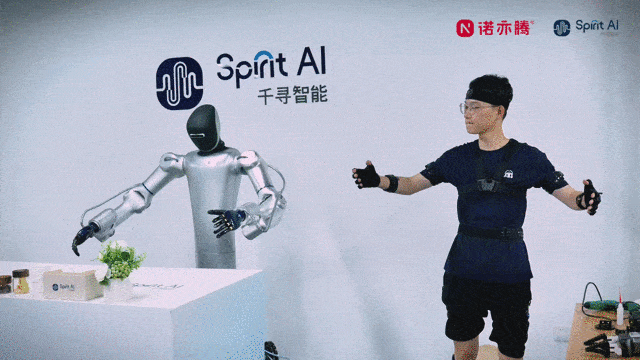
China's Spirit AI Secures Nearly $84 Million in Landmark Deal, Reshaping Humanoid Robotics Landscape
China's Spirit AI Secures Nearly $84 Million in Landmark Deal, Reshaping Humanoid Robotics Landscape
JD.com Leads Strategic Investment in Emerging Force-Control Robotics Pioneer
Beijing-based Spirit AI has secured nearly 600 million yuan ($84 million) in Pre-A+ financing, with e-commerce giant JD.com taking the lead investor position. The funding announcement, made public on July 21, 2025, represents one of the largest early-stage investments in China's rapidly evolving humanoid robotics sector.
The financing round brings together an impressive consortium of strategic backers, including the China Internet Investment Fund, Zhejiang Science and Innovation Mother Fund, Huatai Zijin, and Fosun RZ Capital. Existing shareholders, including Saudi Aramco's Prosperity7 Ventures, Xiaomi-affiliated Shunwei Capital, and five other institutional investors, demonstrated their continued confidence through significant over-subscription.
"This isn't merely capital raising—it's the formation of an industrial alliance," noted a senior analyst at a leading Beijing technology investment firm. "The 'capital plus industry' approach gives Spirit AI both the financial runway and the real-world testing grounds essential for commercializing humanoid technology."

From Zero to Moz in 16 Months
Founded just last year by Han Fengtao, the former CTO of industrial robotics company Rokae, Spirit AI has moved with remarkable velocity. Within its first six months of existence, the company had already secured nearly 200 million yuan through seed and angel rounds, attracting a diverse investor base spanning Middle Eastern sovereign funds and Chinese technology conglomerates.
The company's technical breakthrough came in June 2025 with the unveiling of Moz1—China's first high-performance force-controlled humanoid robot featuring 26 degrees of freedom. Powered by Spirit AI's proprietary Vision-Language-Action model, the Moz1 represents a significant technical achievement, combining self-developed high-power-density integrated force-controlled joints with high-precision whole-body control algorithms.
"What sets Spirit apart isn't just the machine—it's the integration of their dual systems approach," explained an industry observer familiar with the company's technology. "Their L1 reflex system handles immediate responses while the L2 planning layer manages complex decision-making—similar to how human cognition works but engineered for industrial reliability."
The Battlefield for Embodied Intelligence
The financing comes at a pivotal moment in the humanoid robotics industry. According to a 2024 Goldman Sachs report, the sector is projected to reach approximately $38 billion by 2035, though more optimistic forecasts from Morgan Stanley suggest the global market could approach $154 billion by the same year.
Spirit AI's competitive positioning has become increasingly clear in recent months. While American rival Figure AI secured a headline-grabbing $675 million Series B at a $2.6 billion valuation earlier last year, Spirit has focused on developing what some experts consider a more sustainable technical advantage: force-controlled actuators produced at significantly lower costs thanks to Chinese domestic supply chains.
"In-house 400W joint modules with 3.4 kW/kg power density that cost 30-40% less than Western equivalents—that's not just a temporary advantage, that's a structural moat," observed a hardware specialist tracking the sector.
Strategic Alliance with JD.com Opens Data Floodgates
Perhaps the most significant aspect of the financing isn't the capital itself but the strategic partnership with JD.com, which offers Spirit AI access to invaluable real-world robotics data from the e-commerce giant's vast logistics network.
This partnership potentially gives Spirit AI access to hundreds of millions of pick-and-place trajectories annually from JD's million-plus mobile robots—a data flywheel that competitors like Figure and Tesla must still synthetically simulate. For training advanced AI models, this real-world data advantage could prove decisive.
"Data is the new oil in robotics," commented a venture capital investor focused on AI investments. "Spirit's JD partnership isn't just about distribution channels—it's about bootstrapping their learning systems with authentic, messy, real-world interaction data that no simulation can perfectly replicate."
Challenges Loom Despite Funding Success
Despite the impressive financing round, Spirit AI faces formidable challenges. The company's force joints currently demonstrate a mean-time-between-failures of approximately 2,000 hours—far short of the 20,000-hour requirement for automotive plant implementations. Until this reliability gap closes, volume orders may remain elusive.
Geopolitical tensions also cast a shadow over the company's international ambitions. New U.S. outbound investment screening measures implemented in January 2025 flagged advanced robotics as a "national-security-sensitive technology," potentially complicating Spirit AI's ability to secure follow-on funding from American limited partners.
Competition within China is intensifying as well. Nine other Chinese humanoid startups collectively raised over 4 billion yuan in the first half of 2025 alone, driving intense competition for specialized engineering talent in servo systems, perception, and safety.
Investment Outlook: Specialized Exposure May Outperform Direct Stakes
For investors eyeing exposure to the humanoid robotics revolution, analysts suggest a nuanced approach might yield better risk-adjusted returns than direct equity in full-stack developers.
"Component vendors, particularly those supplying critical actuators, batteries, and visual-force sensors, offer broader exit optionality while avoiding winner-takes-all dynamics," suggested an investment strategist at a Shanghai-based fund. "The companies manufacturing high-performance harmonic drives and specialized control systems will sell to every successful OEM, regardless of which humanoid platform ultimately dominates."
Those still drawn to the transformative potential of full-stack humanoid developers should be prepared for high risk and potential dilution, with industry advisors recommending reserves for 2-3x follow-on investments. The sector appears to be tracking toward a "winner-takes-most" outcome, with projected 5-year IRR targets for category leaders in the 35-40% range.
Investment Disclaimer: The projections discussed represent informed analysis rather than guaranteed outcomes. Past performance doesn't guarantee future results. Readers should consult qualified financial advisors for personalized guidance based on their specific circumstances and risk tolerance.
As Spirit AI prepares to deploy Moz1 in automotive factory pilots later this year, the embodied intelligence sector appears poised at an inflection point between technical validation and commercial deployment. Whether the company's technical advantages and strategic partnerships will translate into sustainable market leadership remains to be seen, but with nearly 800 million yuan in total funding, Spirit AI has secured its position as a serious contender in the global race to bring capable humanoid robots from science fiction into everyday reality.